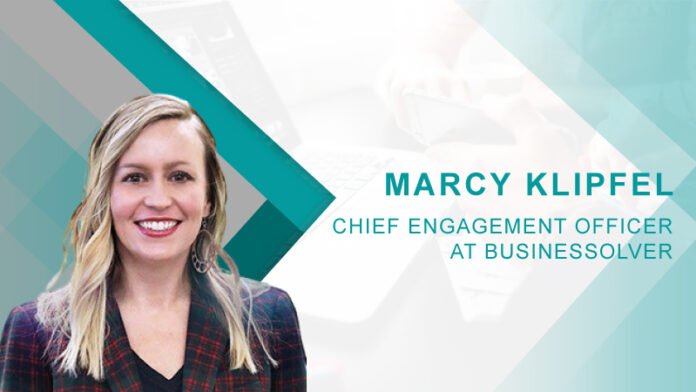Marcy, we’re delighted to have you at HRTech Cube. Could you please share your professional journey and how it led to your current role as Chief Engagement Officer at Businessolver?
I came up in the HR industry, starting my career as a consultant at Willis Towers Watson, and then spending over a decade at General Growth Properties as their VP of HR. From there, I moved to Senior VP of HR at Kum & Go, a national chain of convenience stores. One of the constants throughout my career has been a focus on organizational excellence and employee engagement. That starts with listening to, investing in, and taking care of your people. Employee benefits are one piece of that puzzle. Throughout my career, I’ve helped my peers and colleagues bring more of the employee perspective into the strategic decision-making and feedback processes at the executive level.
Businessolver’s 2024 State of Workplace Empathy research highlights the growing importance of empathy in the workplace. What were some of the key findings from this year’s report, and how do they reflect changing workforce dynamics?
Among the standout findings this year, a high percentage of employees reported experiencing mental health issues and working in environments they consider toxic. CEOs in particular were surprisingly and strikingly candid—55% reported experiencing mental health issues, and 52% agreed their workplace was toxic. And yet, the overwhelming majority of all respondents, including 81% of CEOs, agreed that companies view someone with mental health issues as weak or a burden.
These findings make it clear that mental health in the workplace should be an important conversation. Organizations that make empathy a core value consider an employee’s entire wellbeing across their physical, mental, and emotional health and find ways to be supportive. Based on the way many employees are feeling, there is much room for workplace empathy to grow.
How do you define empathy in the context of employee benefits administration, and why is it critical for businesses to prioritize empathetic solutions in today’s workplace?
Research supports that organizations that prioritize the wellness of their employees are more productive, experience less turnover, and have a more positive workplace culture. This makes empathic solutions not just “feel-good” initiatives, but a strategic business imperative.
In our study, empathy is defined as “the ability to understand and/or experience the feelings or perspectives of another.” In the context of employee benefits, this means considering the range of needs experienced by a diverse workforce and offering benefits solutions that are personalized, proactive, and accessible.
From your perspective, what role does empathy play in building more positive and productive workplaces, and how does Businessolver’s research support this idea?
We have first-hand experience in building an empathy-centered workplace culture ourselves. The Businessolver success story offers proof that corporate growth and employee empathy are not mutually exclusive—in fact, they are very synergistic. In recent years, we transitioned to a fully remote organization, because that reflected our employees’ desire for greater flexibility. Not only has our company performance continued to climb, but we’ve been able to attract exceptional talent from across nearly all 50 states.
Every month, we employ an employee listening strategy we call “Employee Pulse.” It’s a practice of regularly surveying employees to gauge their satisfaction, engagement, and overall sentiment. It helps us maintain a real-time understanding of our employees’ needs and concerns so we can implement changes and improve our company culture.
Our external research also confirms that empathetic employers inspire deeper engagement and loyalty from employees. A majority of respondents surveyed in our 2024 State of Workplace Empathy study said they would be willing to work longer hours and take slightly less pay for a more empathetic employer.
Empathetic employee benefits administration is a unique concept. Can you explain how Businessolver integrates empathy into its benefits platform and the impact it has on employee engagement and well-being?
We put people at the heart of our technology, and ultimately, this is what sets us apart from other benefits administration platforms. We talk about the use of “empathetic AI,” which means technology that is purposefully designed to offer a personalized and understanding approach to the employee benefits experience.
From initial enrollment through year-round engagement, our benefits technology works to understand and address each individual’s unique needs, circumstances, and emotions. This may include proactive prompts to encourage benefit use when relevant, simplifying detailed plan documents, offering 24/7 virtual support, assisting live advocates on calls, and addressing underlying concerns to anticipate and resolve questions more effectively. These interactions occur across mobile, web, IVR, and chat, providing employees with accessible, empathetic support in their preferred communication channels.
What are some of the practical strategies Businessolver has adopted to promote employee wellness through empathetic leadership and benefits offerings?
Employee wellbeing is so important that we have a full-time employee wellness director dedicated to it. We put a comprehensive lens on wellness that spans a wide array of initiatives including physical, mental, emotional, and even financial wellbeing. These are among our top-used benefits, across all employee demographics. Our weekly physical wellness programming, for example, garners nearly 40% employee participation year-round. It encompasses a variety of offerings that include group exercise sessions, health education, and motivational challenges such as weight loss or step goals.As another example, since becoming a fully remote organization, we began to offer support and accountability groups that have become very popular. Anyone from the organization can join a one-hour virtual meeting, during which they set an individual goal for the hour. At the end of the hour, each person shares what they accomplished, and most are surprised by the increased level of motivation and productivity they experience.
As a leader focused on engagement, what personal strategies do you rely on to foster a culture of empathy and inclusivity within your teams?
Employee feedback is one of our most valuable resources. It’s why we have made regularly taking the pulse of employees a formal strategy. It helps us understand more about our workforce, including their needs, wants, and challenges while providing real data to take action on.
But feedback has to be more than just a survey—your actions have to be intentional and authentic. At Businessolver, we’ve invested in building connection and community within our organization, especially since going fully remote. For us, this includes a weekly all-hands update we call “What’s Going On,” where everyone gets face-time with organizational leaders. We also take time throughout each month to recognize employees for their anniversaries and accomplishments. At the team level, we provide ongoing leadership training to support our people leaders with resources and feedback to take back to their teams as needed.
But at the end of the day, our best and most reliable strategy is listening to our people and then responding in kind.
In your view, what are some of the biggest challenges companies face in fostering empathy in the workplace, and how can they overcome these obstacles?
I think there are a number of challenges, but there were a couple that stood out in this year’s empathy research: many people were unwilling to be vulnerable in that way, or worried they would be perceived as weak. Beyond a pervasive mental health stigma, our research uncovered an “empathy stigma” that looms large among both employees and leadership. In fact, 42% of employees who participated in this year’s empathy survey said they find it difficult to show empathy in the workplace. The reasons included concerns about not being supported by peers or losing respect, not knowing how to express empathy, and not being raised to express empathy.
What’s more, the percentage of CEOs who said they find it difficult to show empathy was even higher at 63%. In fact, a concerning number of those surveyed, 37%, said empathy doesn’t have a place in the workplace altogether. When you consider how much of an impact company leadership has on organizational culture, it’s not surprising that fostering empathy can be an uphill battle for many organizations. Leading by example and implementing policies and culture that support empathetic behaviors can go a very long way.
For organizations looking to improve workplace empathy and employee wellness, what advice would you offer based on your expertise and Businessolver’s research?
Interestingly, the CEOs, HR, and employees we surveyed universally want empathy, but fail to model the behaviors they value. We analyzed 20 empathetic behaviors that were rated by our respondents, and found that the foundation of an empathetic culture rests on the ability to support employees across three pillars:
– Support the professional with meaningful career development and working arrangements that help them thrive.
– Support the whole person by acknowledging and supporting the need to balance work and home.
– Support their community by fostering a sense of belonging within teams and communities at work.
There is no one-size-fits-all approach to empathy, but following these principles provides a valuable framework for each organization to tailor.
Finally, as we wrap up, do you have any final thoughts on how empathy can reshape the future of work and employee well-being?
It starts first by recognizing that empathy is a powerful force. When organizations embrace empathy, they acknowledge the unique experiences and challenges employees face and find ways to equip employees to thrive personally and professionally. I think we’ll see more manifestations of this in the future, such as mental health support, flexible work arrangements, and AI-powered assistance tailored to individual needs.
Ultimately, the path to improved morale, engagement, and company performance is paved with empathy. We believe empathetic workplaces build a strong foundation for long-term organizational success in today’s evolving workforce landscape.

Marcy Klipfel, Chief Engagement Officer at BusinessSolver
Marcy Klipfel is the Chief Engagement Officer at Businessolver. She brings more than 15 years of HR experience overseeing Businessolver’s recruiting, training, compensation, benefits, succession planning, organizational design, compliance, performance management, and driving a high-performance culture. Prior to joining Businessolver, Marcy held other senior-level HR roles, including more than a decade at General Growth Properties, where she served as Vice President of HR. She also served as the Senior Vice President of HR with Kum & Go. Her career in human resources began with Towers Watson, where she held various consulting roles in total compensation as well as executive compensation. Outside of work, Marcy has a passion for volunteerism and community service. She’s served on the Board of Directors for the Iowa Citizens Foster Care Review Board and in various leadership roles for the Kappa Alpha Theta Des Moines Area Alumnae Chapter. Marcy also is a sustaining member of the Des Moines Junior League, serves on the Couture for a Cause committee benefiting Children’s Cancer Connection as well as on the Annie’s Ride committee benefiting MS. Marcy studied journalism and business, and also received her Executive M.B.A. – all at the University of Iowa.












